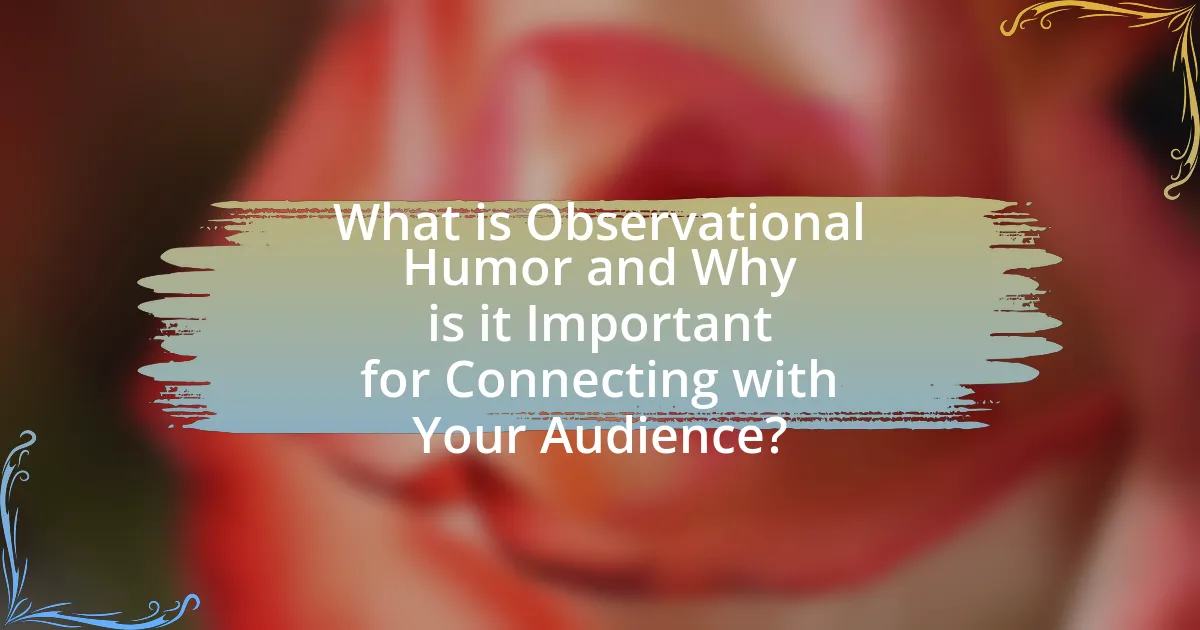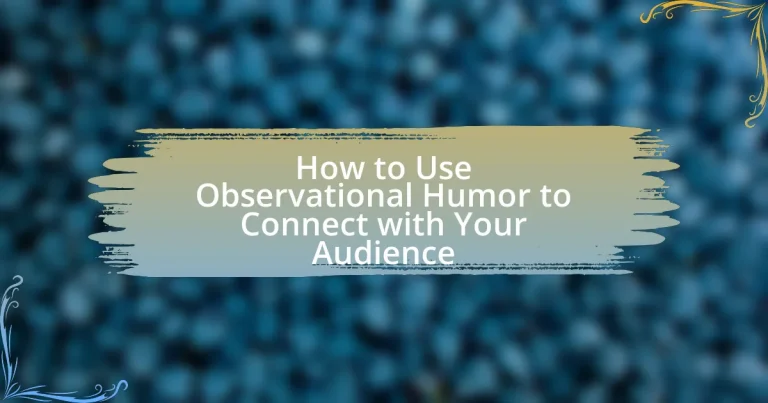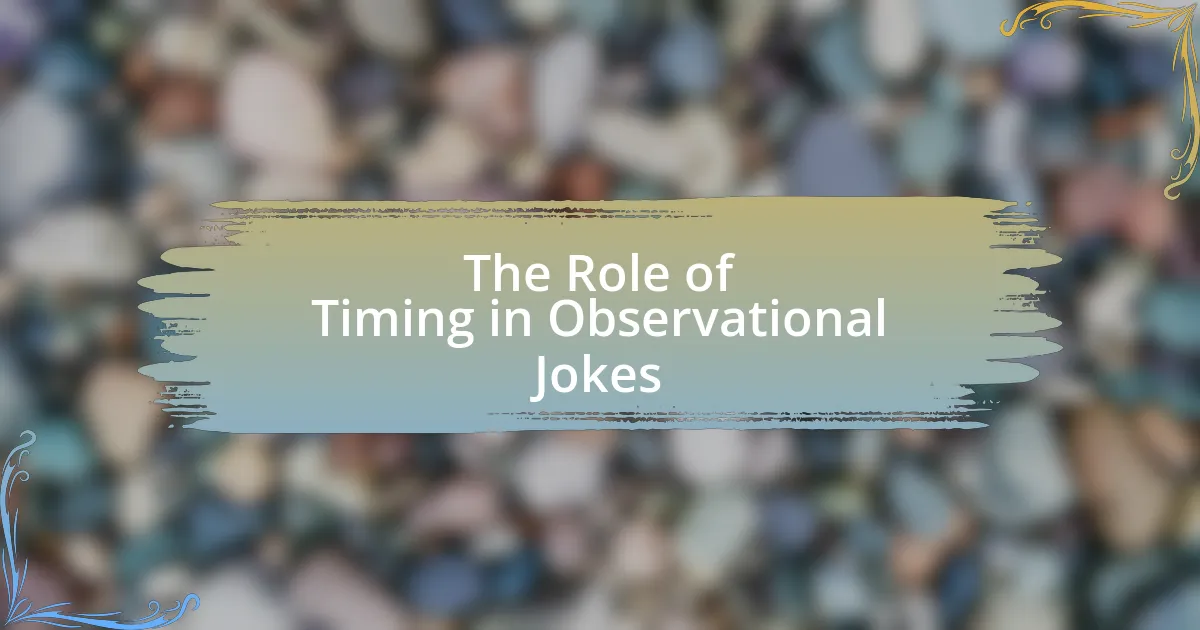Observational humor is a comedic style that relies on everyday experiences and relatable situations to foster connections with audiences. This article explores the significance of observational humor in enhancing relatability, audience engagement, and effective communication. It outlines the key characteristics of this humor style, differentiates it from other types, and discusses its psychological effects on listeners. Additionally, the article provides practical tips for identifying opportunities for observational humor, tailoring it to specific audiences, and effectively delivering it in various contexts. By understanding and applying these principles, communicators can enhance their ability to connect with their audience through humor.

What is Observational Humor and Why is it Important for Connecting with Your Audience?
Observational humor is a comedic style that draws on everyday experiences and common situations to elicit laughter. This type of humor is important for connecting with an audience because it fosters relatability; when people recognize their own experiences in the humor, they feel a sense of shared understanding. Research indicates that humor can enhance social bonds and improve communication, making it a valuable tool for engaging audiences effectively. For instance, a study published in the Journal of Personality and Social Psychology found that humor can increase likability and trustworthiness, which are crucial for audience connection.
How does Observational Humor differ from other types of humor?
Observational humor differs from other types of humor primarily in its focus on everyday experiences and relatable situations. While other humor styles, such as slapstick or dark humor, often rely on exaggerated scenarios or taboo subjects, observational humor draws its comedic value from the mundane aspects of life that audiences can easily recognize and identify with. This relatability fosters a connection between the comedian and the audience, as seen in the works of comedians like Jerry Seinfeld, who often highlight the absurdities of daily routines.
What are the key characteristics of Observational Humor?
Observational humor is characterized by its focus on everyday experiences and relatable situations. This type of humor often highlights the absurdities and quirks of daily life, making it accessible to a wide audience. Key characteristics include a keen observation of social norms, a conversational tone, and the ability to find humor in mundane activities. For instance, comedians like Jerry Seinfeld have successfully utilized observational humor by discussing common experiences, such as waiting in line or dealing with traffic, which resonate with many people. This relatability fosters a connection between the comedian and the audience, enhancing the overall comedic effect.
Why is Observational Humor effective in communication?
Observational humor is effective in communication because it resonates with shared experiences, making the audience feel understood and connected. This type of humor highlights everyday situations that people can relate to, fostering a sense of camaraderie. Research indicates that humor can enhance message retention and engagement; for instance, a study published in the Journal of Personality and Social Psychology found that humor increases audience attention and recall of information. By using observational humor, communicators can break down barriers, create a relaxed atmosphere, and facilitate open dialogue, ultimately leading to more effective interactions.
What role does Observational Humor play in audience engagement?
Observational humor plays a crucial role in audience engagement by creating relatable connections between the performer and the audience. This type of humor draws on everyday experiences and common situations, allowing audiences to see themselves in the jokes, which fosters a sense of shared understanding and camaraderie. Research indicates that humor enhances memory retention and increases audience enjoyment, making them more likely to engage with the content presented. For instance, a study published in the journal “Communication Research” found that humor can significantly improve audience recall of information, demonstrating its effectiveness in maintaining attention and enhancing the overall experience.
How can Observational Humor enhance relatability with the audience?
Observational humor enhances relatability with the audience by reflecting shared experiences and everyday situations that resonate with them. This type of humor draws on common life scenarios, making it easier for individuals to see themselves in the jokes, thus fostering a sense of connection. Research indicates that humor based on relatable content can increase audience engagement and emotional response, as it taps into familiar feelings and thoughts. For instance, a study published in the Journal of Communication found that humor that aligns with audience experiences significantly boosts their enjoyment and connection to the material presented.
What psychological effects does Observational Humor have on listeners?
Observational humor positively affects listeners by enhancing their mood and fostering social connections. This type of humor often highlights shared experiences, which can create a sense of belonging among the audience. Research indicates that laughter triggers the release of endorphins, promoting feelings of happiness and reducing stress. A study published in the journal “Psychological Science” by Robert Provine found that laughter can strengthen social bonds and improve group cohesion, demonstrating the psychological benefits of humor in social settings.

How Can You Identify Opportunities for Observational Humor?
To identify opportunities for observational humor, one should actively observe everyday situations and interactions for relatable, common experiences. This involves paying attention to the nuances of human behavior, social norms, and the absurdities of daily life, which often provide fertile ground for humor. Research indicates that humor is most effective when it resonates with shared experiences, as highlighted in studies on social bonding and laughter, such as those conducted by Robert Provine, which demonstrate that laughter often arises from recognizing the incongruities in routine situations. By honing observational skills and being attuned to the environment, individuals can uncover moments that are ripe for humor, making their comedic content more engaging and relatable to their audience.
What everyday situations can inspire Observational Humor?
Everyday situations that can inspire observational humor include mundane activities like commuting, grocery shopping, and family interactions. These scenarios often reveal relatable quirks and absurdities of daily life, making them ripe for comedic exploration. For instance, the frustrations of traffic jams highlight the universal experience of impatience, while the oddities of shopping behaviors, such as people misplacing items or engaging in awkward small talk, showcase human nature’s eccentricities. Additionally, family dynamics, such as the humorous misunderstandings that arise during family gatherings, provide rich material for humor due to their familiarity and emotional resonance.
How can you train yourself to notice humorous details in daily life?
To train yourself to notice humorous details in daily life, actively practice mindfulness and observation. Engaging in mindfulness helps you become more aware of your surroundings, allowing you to identify quirky behaviors, unexpected situations, and amusing interactions that often go unnoticed. Research indicates that mindfulness can enhance creativity and observational skills, which are crucial for recognizing humor in everyday scenarios. For instance, a study published in the journal “Psychological Science” found that individuals who practiced mindfulness were better at noticing details in their environment, leading to increased creativity and humor appreciation. By consistently applying mindfulness techniques, such as focusing on the present moment and observing without judgment, you can improve your ability to spot humorous elements in daily life.
What are some common themes in Observational Humor?
Common themes in observational humor include everyday life experiences, social norms, and human behavior. These themes often highlight the absurdities and quirks of daily routines, such as interactions in public spaces, family dynamics, and the challenges of modern technology. For instance, comedians like Jerry Seinfeld frequently draw on mundane situations, such as waiting in line or dealing with telemarketers, to create relatable content that resonates with audiences. This relatability is crucial, as it fosters a connection between the comedian and the audience, making the humor more impactful.
How can you tailor Observational Humor to your specific audience?
To tailor observational humor to your specific audience, first, understand their demographics, interests, and cultural references. This understanding allows you to select relatable topics and experiences that resonate with them. For example, if your audience consists of young professionals, referencing common workplace scenarios or technology trends will likely elicit laughter. Research indicates that humor is most effective when it aligns with the audience’s shared experiences and values, as highlighted in studies on social identity theory, which show that people find humor more enjoyable when it reflects their own social group.
What factors should you consider about your audience when using Observational Humor?
When using observational humor, consider the audience’s demographics, cultural background, and shared experiences. These factors influence how humor is perceived and appreciated. For instance, age can affect references; younger audiences may not relate to jokes about older technology. Cultural background shapes humor sensitivity; what is funny in one culture may be offensive in another. Shared experiences, such as common life situations or societal norms, enhance relatability, making humor more effective. Understanding these factors ensures that the humor resonates and fosters connection rather than alienation.
How can cultural differences affect the reception of Observational Humor?
Cultural differences significantly affect the reception of observational humor by influencing the context, references, and social norms that shape humor appreciation. For instance, humor that relies on specific cultural references may resonate well within one culture but be completely misunderstood in another, as seen in studies where jokes based on local customs or idioms fail to translate across cultures. Research by Martin and Ford (2018) highlights that humor appreciation is often tied to shared experiences and values, meaning that observational humor that aligns with the audience’s cultural background is more likely to be well-received. Additionally, cultural attitudes towards humor, such as whether it is seen as a form of social bonding or a potential source of offense, can further dictate how observational humor is interpreted and enjoyed.

What Techniques Can You Use to Effectively Deliver Observational Humor?
To effectively deliver observational humor, utilize techniques such as relatable anecdotes, timing, and emphasis on shared experiences. Relatable anecdotes create a connection with the audience by reflecting common situations they have encountered, making the humor more impactful. Timing is crucial; delivering the punchline at the right moment enhances the comedic effect, as evidenced by studies showing that well-timed jokes are perceived as funnier. Emphasizing shared experiences allows the audience to see themselves in the humor, fostering a sense of community and understanding. These techniques are supported by research indicating that humor is most effective when it resonates with the audience’s own life experiences.
How can timing and delivery enhance your Observational Humor?
Timing and delivery significantly enhance observational humor by creating a rhythm that maximizes comedic impact. Effective timing ensures that punchlines land at the right moment, allowing the audience to process the setup before the humor hits, which can increase laughter. For instance, comedians often pause before delivering a punchline to build anticipation, a technique supported by studies in comedic timing that show well-timed jokes can increase audience engagement and response rates. Additionally, delivery style, including vocal inflection and body language, can amplify the humor by adding layers of meaning and emotion, making the observational humor more relatable and memorable. Research indicates that humor is often perceived as funnier when delivered with confidence and appropriate pacing, reinforcing the idea that both timing and delivery are crucial elements in enhancing observational humor.
What are the best practices for pacing your humor?
The best practices for pacing your humor involve timing, delivery, and audience engagement. Effective humor relies on well-timed punchlines, which should follow a setup that allows the audience to anticipate the joke without losing interest. Research indicates that comedians often use pauses strategically; for instance, a study by the University of Southern California found that well-placed pauses can enhance comedic timing and audience response. Additionally, varying the rhythm of delivery keeps the audience engaged, as monotony can diminish the impact of humor. Observational humor should also be tailored to the audience’s reactions, allowing for adjustments in pacing based on their responses, which fosters a stronger connection.
How can body language and facial expressions contribute to your delivery?
Body language and facial expressions significantly enhance delivery by reinforcing verbal messages and engaging the audience. Effective body language, such as open gestures and appropriate posture, conveys confidence and helps establish a connection with the audience, making the delivery more relatable. Facial expressions, like smiling or raising eyebrows, can emphasize humor and emotional content, facilitating a stronger emotional response from the audience. Research indicates that nonverbal communication accounts for up to 93% of the emotional impact of a message, highlighting its critical role in effective delivery.
What are some common pitfalls to avoid when using Observational Humor?
Common pitfalls to avoid when using observational humor include relying on stereotypes, being overly negative, and failing to connect with the audience’s experiences. Stereotypes can alienate individuals and reinforce biases, which detracts from humor’s intent to unite. Overly negative humor can create discomfort and disengagement, as audiences often prefer light-heartedness. Additionally, if the humor does not resonate with the audience’s shared experiences, it may fall flat, leading to a lack of connection. These pitfalls can undermine the effectiveness of observational humor in fostering audience engagement.
How can you ensure your humor is appropriate for the context?
To ensure your humor is appropriate for the context, assess the audience and setting before delivering any jokes. Understanding the demographics, cultural backgrounds, and sensitivities of your audience allows you to tailor your humor effectively. For instance, humor that is acceptable in a casual gathering may not be suitable in a professional environment. Research indicates that humor can enhance communication and connection when it aligns with the audience’s values and expectations, as noted in studies on social dynamics and humor perception.
What should you do if your Observational Humor doesn’t land as expected?
If your observational humor doesn’t land as expected, acknowledge the moment and pivot to a different topic or joke. This approach allows you to maintain the audience’s engagement and diffuse any awkwardness. Research indicates that comedians often use self-deprecating humor or relatable anecdotes to recover from failed jokes, which can help re-establish a connection with the audience. For instance, a study by the University of California found that humor that reflects vulnerability can enhance audience rapport, making it easier to regain their attention after a misfire.
What are some practical tips for incorporating Observational Humor into your presentations?
To effectively incorporate observational humor into your presentations, focus on relatable experiences that resonate with your audience. Start by observing everyday situations or common challenges that your audience faces, as these can serve as the foundation for your humor. For instance, referencing shared experiences, such as commuting woes or office dynamics, can create an instant connection.
Additionally, timing is crucial; deliver your humorous observations at strategic points to maintain engagement and enhance the overall message. Research indicates that humor can increase retention of information, making your presentation more memorable. According to a study published in the Journal of Business Communication, humor can improve audience engagement and comprehension when used appropriately.
Finally, practice your delivery to ensure that your humor feels natural and spontaneous, rather than forced. This authenticity will help your audience relate to your observations, making the humor more effective.





